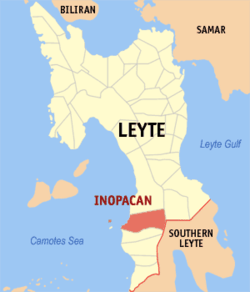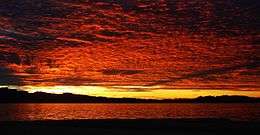Inopacan, Leyte
| Inopacan | |
|---|---|
| Municipality | |
 Map of Leyte with Inopacan highlighted | |
.svg.png) Inopacan Location within the Philippines | |
| Coordinates: 10°30′N 124°45′E / 10.500°N 124.750°ECoordinates: 10°30′N 124°45′E / 10.500°N 124.750°E | |
| Country | Philippines |
| Region | Eastern Visayas (Region VIII) |
| Province | Leyte |
| Congr. district | 5th district of Leyte |
| Barangays | 20 |
| Government[1] | |
| • Mayor | Silvestre T. Lumarda |
| Area[2] | |
| • Total | 94.62 km2 (36.53 sq mi) |
| Population (2010)[3] | |
| • Total | 19,904 |
| • Density | 210/km2 (540/sq mi) |
| Time zone | PST (UTC+8) |
| ZIP code | 6522 |
| Dialing code | 53 |
| Website |
www |
Inopacan is a fourth class municipality in the province of Leyte, Philippines. In the south, it borders with the town of Hindang and Camotes Sea in the west. According to the 2010 census, it has a population of 19,904 people.[3]
Apid and Mahaba Islands, part of the Cuatro Islas, are within the administrative jurisdiction of the municipality of Inopacan.
Etymology
The name of the town is a namesake of a legendary winged hero named by the natives as “Inong pak-an”, according to old folks. But history tells that Inopacan is a new name of Canamocan which was a pre-Spanish settlement according to Lee W. Vance in his book, Tracing our Ancestor and the analytical understanding of the written manuscripts of the Jesuit missionaries in Leyte. However, it remains unaccepted despite that Canamocan was mentioned as now 'Inopacan' by some authors like Atty. Francisco Tantuico of the history of Baybay, Locsin on Ormoc's History, and Eduardo Makabenta Sr. on Carigara's History.
Barangays
Inopacan is politically subdivided into 20 barangays.
- Apid
- Cabulisan
- Caminto
- Can-angay
- Caulisihan
- Conalum
- De los Santos (Mahilum)
- Esperanza
- Guadalupe
- Guinsanga-an
- Hinabay
- Jubasan
- Linao
- Macagoco
- Maljo
- Marao
- Poblacion
- Tahud
- Taotaon
- Tinago
History
Much of the documents that could be a good source for learning about the history of Inopacan were destroyed when the town hall as well as the parish church and its convent were leveled into rubbles as the Japanese war planes bombed these buildings during the World War II. But based on the account of Inopacnon elders and records from neighboring towns, Inopacan was once a barangay of Hindang. with Fernando Polistico (a Boholano) as the first appointed Capitan del Barrio, and was succeeded by Francisco Espinoza, and lastly by Agustín Kudéra before Inopacan became a town on December 6, 1892.[4]
Demographics

| Population census of Inopacan | ||
|---|---|---|
| Year | Pop. | ±% p.a. |
| 1990 | 16,894 | — |
| 1995 | 18,864 | +2.09% |
| 2000 | 18,680 | −0.21% |
| 2007 | 19,276 | +0.43% |
| 2010 | 19,904 | +1.17% |
| Source: National Statistics Office[3] | ||
References
- ↑ "Municipalities". Quezon City, Philippines: Department of the Interior and Local Government. Retrieved 24 June 2013.
- ↑ "Province: Leyte". PSGC Interactive. Makati City, Philippines: National Statistical Coordination Board. Retrieved 2 July 2013.
- 1 2 3 "Total Population by Province, City, Municipality and Barangay: as of May 1, 2010" (PDF). 2010 Census of Population and Housing. National Statistics Office. Retrieved 2 July 2013.
- ↑ Inopacan Leyte and the Inopacnons by Edgie Polistico, see this link: http://inopacan.blogspot.com/2010/03/history-of-inopacan-in-my-years-of.html
External links
| Wikivoyage has a travel guide for Inopacan. |
- Inopacan Official Website
- Philippine Standard Geographic Code
- Philippine Census Information
- Local Governance Performance Management System
 |
Baybay | Mahaplag |  | |
| Camotes Sea | |
|||
| ||||
| | ||||
| Hindang | Sogod, Southern Leyte |